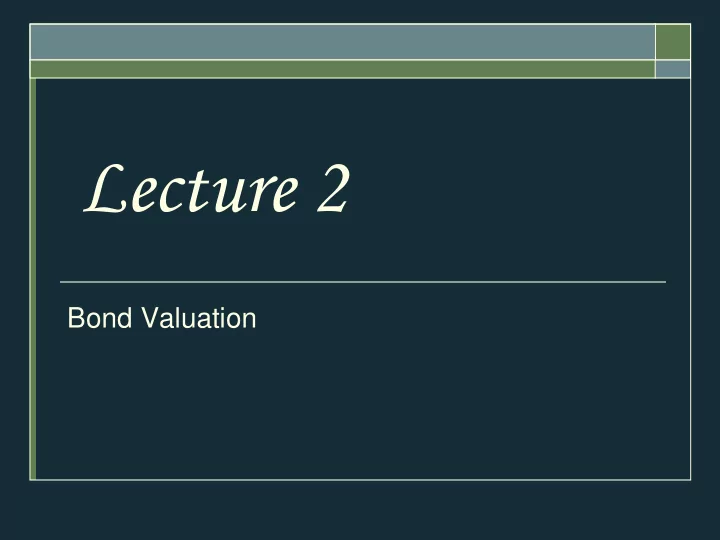

Lecture 2 Bond Valuation
Contact: Natt Koowattanatianchai Email: fbusnwk@ku.ac.th Homepage: http://fin.bus.ku.ac.th/nattawoot.htm Phone: 02-9428777 Ext. 1218 Mobile: 087- 5393525 Office: 9 th Floor, KBS Building, Kasetsart University 8-1
Outline 1 Bonds and Bond Valuation 2 Calculating Bond Yields 8-2
References Ross, S., Westerfield, R. and Jaffe, J. (2013), Corporate Finance (10 th Edition), McGraw Hill/Irvin. (Chapter 8) Moyer, R.C., McGuigan, J.R., and Rao, R.P. (2015), Contemporary Financial Management (13 th Edition), Cengage Learning. (Chapter 6) 8-3
Bonds and Bond Valuation A bond is a legally binding agreement between a borrower and a lender that specifies the: Par (face) value Coupon rate Coupon payment Maturity Date The yield to maturity is the required market interest rate on the bond. 8-4
Bond Valuation Primary Principle: Value of financial securities = PV of expected future cash flows Bond value is, therefore, determined by the present value of the coupon payments and par value. Interest rates are inversely related to present (i.e., bond) values. 8-5
The Bond-Pricing Equation 1 1 - T F (1 r) Bond Value C T r (1 r) 8-6
Bond Example Consider a U.S. government bond with as 6 3/8% coupon that expires in December 2013. The Par Value of the bond is $1,000. Coupon payments are made semiannually (June 30 and December 31 for this particular bond). Since the coupon rate is 6 3/8%, the payment is $31.875. On January 1, 2009 the size and timing of cash flows are: $ 31 . 875 $ 31 . 875 $ 31 . 875 $ 1 , 031 . 875 12 / 31 / 09 12 / 31 / 13 1 / 1 / 09 6 / 30 / 09 6 / 30 / 13 8-7
Bond Example On January 1, 2009, the required yield is 5%. The current value is: $ 31 . 875 1 $ 1 , 000 1 $ 1 , 060 . 17 PV 10 10 . 05 2 ( 1 . 025 ) ( 1 . 025 ) 8-8
Bond Example Now assume that the required yield is 11%. How does this change the bond’s price? $ 31 . 875 1 $ 1 , 000 1 $ 825 . 69 PV 10 10 . 11 2 ( 1 . 055 ) ( 1 . 055 ) 8-9
YTM and Bond Value When the YTM < coupon, the bond trades at a premium. 1300 Bond Value 1200 When the YTM = coupon, the 1100 bond trades at par. 1000 800 0 0.01 0.02 0.03 0.04 0.05 0.06 0.07 0.08 0.09 0.1 6 3/8 Discount Rate When the YTM > coupon, the bond trades at a discount. 8-10
Bond Concepts Bond prices and market interest rates move in opposite directions. When coupon rate = YTM, price = par value When coupon rate > YTM, price > par value (premium bond) When coupon rate < YTM, price < par value (discount bond) 8-11
Computing Yield to Maturity Yield to maturity is the rate implied by the current bond price. Finding the YTM requires trial and error if you do not have a financial calculator and is similar to the process for finding r with an annuity. Interpolation: lower rate −YTM lower price −market price upper rate −lower rate = upper price −lower price 8-12
YTM with Annual Coupons Consider a bond with a 10% annual coupon rate, 15 years to maturity, and a par value of $1,000. The current price is $928.09. Will the yield be more or less than 10%? 8-13
YTM with Semiannual Coupons Suppose a bond with a 10% coupon rate and semiannual coupons has a face value of $1,000, 20 years to maturity, and is selling for $1,197.93. Is the YTM more or less than 10%? What is the semi-annual coupon payment? How many periods are there? 8-14
Bond Pricing Theorems Bonds of similar risk (and maturity) will be priced to yield about the same return, regardless of the coupon rate. If you know the price of one bond, you can estimate its YTM and use that to find the price of the second bond. This is a useful concept that can be transferred to valuing assets other than bonds. 8-15
Zero Coupon Bonds Make no periodic interest payments (coupon rate = 0%) The entire yield to maturity comes from the difference between the purchase price and the par value Cannot sell for more than par value Sometimes called zeroes, deep discount bonds, or original issue discount bonds (OIDs) Treasury Bills and principal-only Treasury strips are good examples of zeroes 8-16
Pure Discount Bonds Information needed for valuing pure discount bonds: Time to maturity ( T ) = Maturity date - today’s date Face value ( F ) Discount rate ( r ) $ 0 $ 0 $ 0 $ F 2 0 1 1 T T Present value of a pure discount bond at time 0: F PV ( T 1 ) r 8-17
Pure Discount Bonds: Example Find the value of a 15-year zero-coupon bond with a $1,000 par value and a YTM of 12%. $ 0 $ 0 $ 0 $ 1 , 000 30 0 2 29 1 $ 1 , 000 F 30 $ 174 . 11 PV T ( 1 ) ( 1 . 06 ) r 8-18
Questions?
Recommend
More recommend